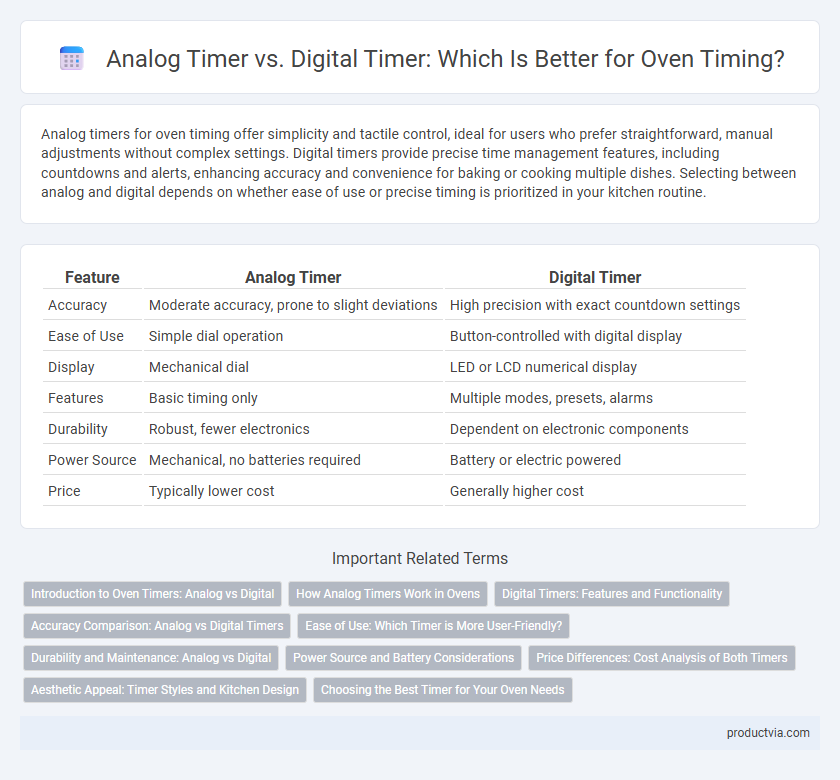Analog timers for oven timing offer simplicity and tactile control, ideal for users who prefer straightforward, manual adjustments without complex settings. Digital timers provide precise time management features, including countdowns and alerts, enhancing accuracy and convenience for baking or cooking multiple dishes. Selecting between analog and digital depends on whether ease of use or precise timing is prioritized in your kitchen routine.
Table of Comparison
| Feature | Analog Timer | Digital Timer |
|---|---|---|
| Accuracy | Moderate accuracy, prone to slight deviations | High precision with exact countdown settings |
| Ease of Use | Simple dial operation | Button-controlled with digital display |
| Display | Mechanical dial | LED or LCD numerical display |
| Features | Basic timing only | Multiple modes, presets, alarms |
| Durability | Robust, fewer electronics | Dependent on electronic components |
| Power Source | Mechanical, no batteries required | Battery or electric powered |
| Price | Typically lower cost | Generally higher cost |
Introduction to Oven Timers: Analog vs Digital
Oven timers are essential for precise cooking, with analog timers offering tactile dials and straightforward operation, while digital timers provide exact countdown displays and programmable settings. Analog timers rely on mechanical components, making them durable but less flexible, whereas digital timers use electronic circuits for accuracy and multiple functions like delayed start and memory recall. Choosing between analog and digital depends on user preference for simplicity or advanced features in oven timing control.
How Analog Timers Work in Ovens
Analog timers in ovens operate through mechanical gears and springs that control the heating duration by physically turning a dial to set the cooking time. As the dial moves, it gradually releases tension in the spring, triggering a switch to turn off the oven once the set time elapses. Their straightforward mechanical design offers reliability without the need for electronic components, making them easy to operate and maintain.
Digital Timers: Features and Functionality
Digital timers for ovens offer precise time settings and easy-to-read displays, enhancing cooking accuracy. Features include programmable countdowns, multiple timers, and automatic shut-off functions that prevent overcooking and energy waste. Advanced models integrate with smart home systems, allowing remote control and real-time notifications for optimal cooking management.
Accuracy Comparison: Analog vs Digital Timers
Digital timers offer superior accuracy for oven timing due to precise electronic components that measure time in exact increments, minimizing deviations common in analog systems. Analog timers rely on mechanical parts that can drift over time, leading to less consistent and less reliable timing. The enhanced precision of digital timers ensures better control over cooking durations, resulting in improved baking and roasting outcomes.
Ease of Use: Which Timer is More User-Friendly?
Analog timers for ovens offer straightforward, tactile controls with easily adjustable dials, making them intuitive for users who prefer simple, mechanical settings. Digital timers provide precise time settings and often feature clear LCD displays and programmable functions, which enhance usability for those accustomed to tech interfaces. User-friendliness depends on individual preference; analog timers appeal to those valuing simplicity, while digital timers cater to users seeking exact timing and multifunction capabilities.
Durability and Maintenance: Analog vs Digital
Analog oven timers often feature mechanical components that can wear out over time, requiring occasional maintenance or replacement, but they are generally durable under regular use. Digital oven timers incorporate electronic circuits that offer precise timing with minimal mechanical wear, reducing the need for frequent maintenance, yet they may be more vulnerable to power surges or moisture damage. Durability-wise, analog timers excel in robustness, while digital timers provide maintenance convenience and accuracy, making the choice dependent on user preference for long-term reliability versus ease of upkeep.
Power Source and Battery Considerations
Analog timers for ovens typically rely on a mechanical power source, eliminating the need for batteries and ensuring uninterrupted operation during power outages. Digital timers often require batteries or a continuous electrical connection, making battery life and replacement an essential factor in their reliability. Choosing between the two depends on balancing maintenance needs against precision and modern functionality.
Price Differences: Cost Analysis of Both Timers
Analog oven timers generally cost less, ranging from $10 to $30, making them a budget-friendly option for basic timing needs. Digital oven timers, priced between $20 and $60, offer advanced features such as precise countdown settings and programmable alerts, which justify the higher cost for users seeking enhanced functionality. The choice between analog and digital timers depends on the value placed on accuracy and additional features relative to the investment.
Aesthetic Appeal: Timer Styles and Kitchen Design
Analog timers on ovens offer a classic and timeless look with their rotary dials and mechanical clicks, complementing traditional or rustic kitchen designs. Digital timers provide a sleek, modern aesthetic with precise numeric displays, fitting seamlessly into contemporary or minimalist kitchens. Choosing between analog and digital timer styles can significantly influence the overall kitchen ambiance, balancing functionality with design preferences.
Choosing the Best Timer for Your Oven Needs
Analog timers offer simplicity and a tactile dial for easy setting, making them ideal for users who prefer straightforward operation without digital distractions. Digital timers provide precise control and customizable programs, enhancing cooking accuracy for recipes requiring exact timing. Choosing the best timer depends on your cooking style, desired precision, and preference for manual vs. automated settings in oven timing.
Analog Timer vs Digital Timer for Oven Timing Infographic

 productvia.com
productvia.com